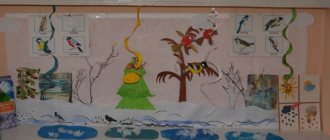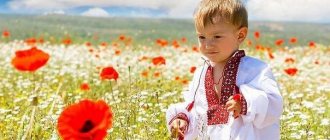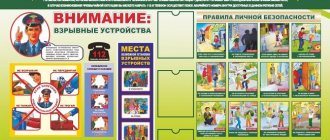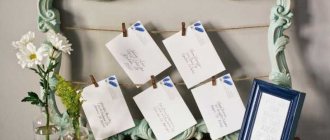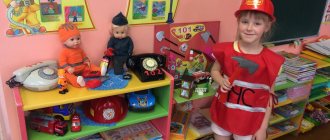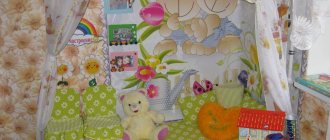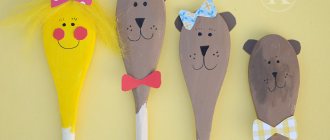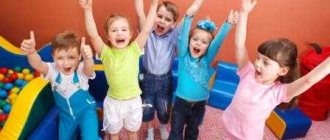DIY design according to Federal State Educational Standards + photo
The safety of children is the most important task for parents, educators and all adults who surround them. Unfortunately, there are a lot of dangers in the world around us that can cause harm. Therefore, it is necessary not only to intensively protect and protect the child, but also to teach him safe behavior in various situations both in the house and outside it. This work is purposefully carried out in all educational institutions, starting from a young age in kindergarten and gives positive results. Because despite the complexity of the organization of modern society, childhood injuries are an emergency situation for which all those responsible bear responsibility.
Safety training in kindergarten
Teaching children not to get into dangerous situations both at home and in the outside world is the most important task for parents and educators in child care institutions. It is necessary to teach children safe behavior from the very first steps of life. There are a large number of situations when a child can get injured at home, on a walk, while playing, or while traveling in public transport. The main task of adults is not only to ensure control over the behavior of children, but also to instill in them the concept of their own safety . a safe behavior corner in kindergarten is intended to solve this problem. Using stands, models, toys, and didactic games, educators teach preschoolers the rules of behavior in the most likely life situations. The materials presented at the stands are also addressed to parents, since the child is with them most of the time, and young parents cannot always properly create a safe environment at home.
Table: studying the rules of life safety in different age groups of kindergarten
Design of a safety corner
The importance of the safety corner in the educational activities of teachers is quite great. But in order to successfully and efficiently teach children the basics of safety, it is necessary to have interesting and varied material in this area of work. The life safety corner may contain:
- Stands with information for parents about possible traumatic situations.
- Analytical reports on emergency incidents involving children.
- Visual materials for teaching safe behavior for children and adults.
- Didactic games (“Road Signs”, “Good and Evil Fire”, “Smart Traffic Light”, “Safety Fundamentals” and so on) factory-made and hand-made.
- Models of fire equipment, ambulance, fire shield - to better familiarize children with emergency services.
- Models of items for personal safety: reflectors, fire detector, fire extinguisher, emergency telephone numbers.
- Toys for organizing role-playing games: firefighter dolls, rescuers, policemen; children's equipment for traffic police and rescue service workers.
- Floor covering for designing traffic when studying traffic rules.
As part of the subject-development environment of the kindergarten, the safety corner must meet the requirements: aesthetic and attractive design for children and parents, functionality and variability, periodic updating of the content to maintain interest in the material.
Providing first aid to the victim: pictures with actions for children
Placing school stands with the basics of first aid in pictures is more than justified from the point of view of the human subconscious. Numerous studies have shown that daily viewing of certain information, particularly in the form of images, is quite successful in remembering, even if it was not carefully read.
In elementary schools, it is preferable to use beautifully designed posters with large drawings or stands, the information content of which should be concise and dynamically replaced (for example, once every 3-6 months). For older children, large corners with a variety of information, both in pictures and in print, are suitable.
first aid stand: templates
first aid pictures
Schemes and images for filling the stands:
action pictures for kids
First aid steps in pictures:
thermal burn
food poisoning
abrasion
solar heatstroke
limb fracture
puncture or cut wound
nose bleed
eye damage
frostbite
fainting
Formation of the middle group.
Svetlana Yurieva
Formation of the middle group.
This summer we moved to a new group . After the previous one, where we lived for 2 years, this group seemed alien , not cozy, and after some thought, our parents decided to organize a cleanup day on their own, which, however, lasted 3 days. Without sparing their weekends, our parents came to our aid.
Assembling the kitchen set
Washed the group after painting
The team has arrived - just right!
Then it’s just a matter of making the group not only clean , bright and spacious, but also interesting for children. That's why I created development centers:
Fine, which was replenished with various means of depiction
Streets of our city according to traffic rules
Music and theater areas
Pochemuchek Corner - experimental zone
Center for Young Mathematicians
Children go to kindergarten with pleasure, everyone will find something to their liking.
Kindergarten decoration File “/upload/blogs/aa327c36105f8186cd0df59e99c44fa3. pg.jpg" not found. Subject-developmental environment of the group (middle preschool age). .
www.maam.ru
Ice safety rules
I remember that as a child, the teacher, releasing the class for the winter holidays, spent class time on the rules of being on the ice, which the students then signed in a special notebook. And we signed that we had learned and adopted the following rules:
- do not walk on ice for no apparent reason;
- do not gather several people in one place;
- what actions to take if the ice cracks under you (sliding steps, feet shoulder-width apart);
- what to take with you on the ice (rope with a load, phone, etc.);
- what to do if you fall through the ice (rolling technique).
The importance of a developing subject-spatial environment in the senior group of preschool educational institutions
The task of any preschool educational institution (DOU) is to create conditions for the development and upbringing of children, maintaining their health in a safe and comfortable environment. The most important component of this task is the organization of a subject-spatial environment that corresponds to the components of the educational and developmental process carried out by teachers. It has long been proven that a child’s development occurs with his active participation in a variety of activities. For senior group students, the following areas are highlighted:
- training and development activities;
- performing practical and creative work;
- role-playing games;
- basics of labor activity;
- physical education classes;
- music and choreography lessons.
The administration of a children's educational institution, teachers and educators must create a multi-component educational environment for a preschooler, which takes into account different aspects of organizing the process of raising and developing a child. This:
- developing subject-spatial environment;
- organizing interaction with teachers;
- communication with peers;
- the preschooler's attitude to the world around him and to himself.
Children should live in a world of beauty, games, fairy tales, music, drawing, fantasy, and creativity.
V. A. Sukhomlinsky
Principles of constructing a subject-development environment
The subject-spatial environment in the older group serves the development of children's activities, primarily play. Indeed, during play, the leading activity of preschool children, cognitive motivation develops, which is the basis of educational activity. The subject-spatial developmental environment must correspond to the zone of proximal mental development of a 5-6 year old child - the formation of prerequisites for educational activity.
Anti-terror pictures for the stand
Anti-terrorism stands are placed within the walls of schools and other educational institutions in order to ensure effective anti-terrorist security of both the facility itself and students and employees.
At the stands you can find all the necessary information, which is updated regularly, namely:
- Activities aimed at identifying and preventing possible terrorist threats.
- Suppression of any initiatives associated with terrorism.
- Algorithm of actions in the event of a terrorist threat.
Poster templates for anti-terror stand:
Materials for filling the stand:
Design of thematic areas in kindergarten
Showing publications 1-10 of 4579. All sections | Corners and centers in groups
Educational environment. Interesting corners in our group
Dear colleagues, I invite you to a mini excursion to our group. Our tour begins with a reception for children and parents. I tried to make it interesting for children and parents; when you go into the locker room you can see a stand “For moms and dads about the lives of their children.” Available at this stand.
Busyboard - educational class=”aligncenter” width=”399″ height=”675″[/img]
Good day, dear friends and guests of my page! Probably, many of you have heard about a development board for children, on which there are various fasteners, doors, buttons, etc. This development center is called a busy board. It was invented by Maria Montesori. Busyboard.
Sources
- Victor Mikhailovich Koryakin Arbitration process in schemes. Tutorial; Prospect - M., 2000. - 370 p.
- Smirnova 100 golden rules. Caring for indoor plants / Smirnova, Maria. - M.: Fiton+, 2008. - 160 p.
- Vox Juris collection. Voice of Law / Collection of articles. - M.: St. Petersburg State University, 2022. - 919 p.
- Alexander, Vasilievich Demin “Soft law” in an era of change: the experience of comparative research. Monograph / Alexander Vasilievich Demin. - M.: Prospekt, 2014. - 182 p.
- Law and Economics No. 08/2010; Justitsinform - M., 2010. - 839 p.
Stands for elementary school pictures
Each classroom corner in an elementary school is a basic information platform for students and their parents. In this classroom area, it is customary to place stands with up-to-date information about the features of children’s adaptation to school, school events, classroom and extracurricular activities.
Since the first days of school are dedicated to new meetings and acquaintances, it is better to start by setting up a stand on the theme “Meet us!”, “Hello school!” etc. For work, you can use templates of posters and classroom corners.
An excellent material for a school stand would be picture reminders for parents of first-graders, which will help prepare their children for school.
Useful cards with rules of behavior, daily routine, information about students for the school stand:

